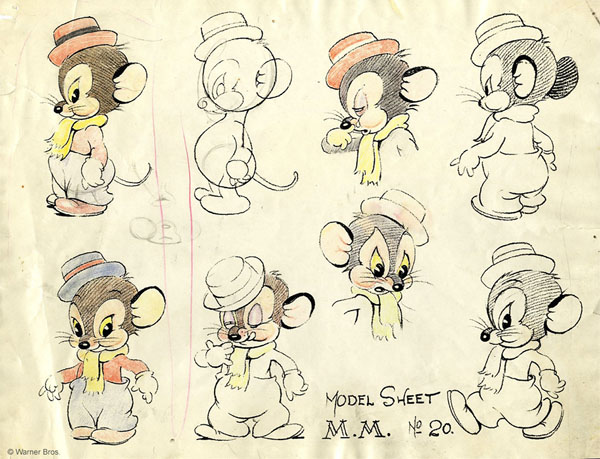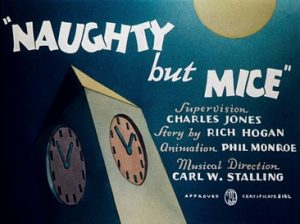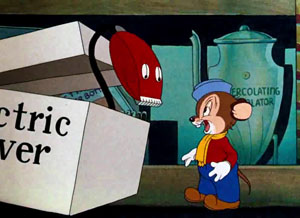
An intoxicated mouse meets an anthropomorphic electric razor. What may seem like a high-concept fever dream in a story pitch meeting gone off the rails is actually the plot of the Warner Bros. Merrie Melodies cartoon, Naughty But Mice, which celebrates its 85th anniversary this year.
 The short is significant in that it introduced a character named Sniffles the mouse, who often gets forgotten when discussing the Warner Bros canon, and it is also one of the early films of director Chuck Jones, who, of course, would become an animation legend.
The short is significant in that it introduced a character named Sniffles the mouse, who often gets forgotten when discussing the Warner Bros canon, and it is also one of the early films of director Chuck Jones, who, of course, would become an animation legend.
Unlike Jones’ later films, known for their fast-paced gags and sharp comedy, Naughty But Mice is more leisurely paced. As the short opens, we meet Sniffles, a cute little mouse with a blue hat and yellow scarf. He is waiting outside the “Savoy Drug Store” late at night. He has a cold and holds a prescription for medicine, but as the drug store is closed, he slips in through the mail slot in the door.
Once inside, Sniffles finds his required medication in a bottle marked “XLNT Cold Cure. Alcohol 125%.” The mouse tips the bottle, pours a spoonful, and downs it. Fire shoots from his mouth, and he must cool himself with a soda left on the counter, but, thanks to the high alcohol content, Sniffles soon finds himself inebriated.
He then bumps into a box on the counter, and out comes an electric razor (with eyes and a voice that sounds like an airplane propeller). When Sniffles sneezes and shares his alcohol-infused cold medication with the razor, the poor electronic device is intoxicated, as well. The two quickly bond and even do a rendition of the song “How Dry I Am.”
After the razor passes out, Sniffles wanders through the store, stumbles into a claw crane arcade machine, and is pursued by a cat, who keeps slipping coins into the machine and maneuvering the claw to capture Sniffles.
However, the mouse’s new friend, the electric razor, soon wakes from their drunken stupor, zooms after the cat, and shaves the villainous feline until the cat runs out of the shop.
 As Naughty But Mice concludes, Sniffles attempts to thank the razor but winds up sneezing again, shooting himself back into the claw machine.
As Naughty But Mice concludes, Sniffles attempts to thank the razor but winds up sneezing again, shooting himself back into the claw machine.
In his book, That’s All Folks: The Art of Warner Bros. Animation, author Steve Schneider writes of Jones’ early films, such as Naughty But Mice:
“For several years, Jones’ cartoons stayed heavily under the Disney influence; The director favored slower and atmospheric pacing, more deliberate character movement, realistic backgrounds, and a striving for ‘cuteness’ throughout. ‘It was a learning time for me,’ said Jones. ‘I wasn’t quite satisfied with the quality of the animation then. That’s why so many of my early pictures are so damn slow – I was trying to find out how to do it.’”
Naughty But Mice hints at the innate comedic brilliance that Jones would become famous for, particularly in the animation of the electric razor, when performing a duet with Sniffles. Also, as Sniffles, in his drunken state, tells the razor to “stay right here” over half a dozen times as he wanders off-screen, we can see Jones’ ability to time and extend a gag to get the perfect laugh.
Assisting with this is great work by actress Margaret Hill-Talbot, who provides the voice of Sniffles. She had worked with Jones before, providing voices for his first cartoon as director, The Night Watchman (1938), and the very Disney-esque Tom Thumb in Trouble (1940). She also provided the voice for Andy Panda for Walter Lantz.
 Also contributing to Naughty But Mice were animator Phil Monroe, story artist Rich Hogan, and musical director Carl Stalling, who would continue to be regular collaborators with Jones. Additionally, Naughty Buy Mice features a beautifully detailed background of the items on the shelf of the drug store, as well as the various prizes in the claw machine. The layout artist on the film was Robert Givens, Art Loomer was the background supervisor, and background artist was Al Tarter (according to IMDb, they are all uncredited).
Also contributing to Naughty But Mice were animator Phil Monroe, story artist Rich Hogan, and musical director Carl Stalling, who would continue to be regular collaborators with Jones. Additionally, Naughty Buy Mice features a beautifully detailed background of the items on the shelf of the drug store, as well as the various prizes in the claw machine. The layout artist on the film was Robert Givens, Art Loomer was the background supervisor, and background artist was Al Tarter (according to IMDb, they are all uncredited).
After Naughty But Mice, Sniffles starred in eleven more cartoon shorts, including Sniffles and the Bookworm (1939), Bedtime for Sniffles (1940), and Sniffles Bells the Cat (1941). The character also had a whole other career in comics, in the series Mary Jane and Sniffles, where he was paired up with a young girl who could shrink to mouse size.
At the time, Sniffles was also featured in other merchandise, such as figurines.
Since his debut and subsequent short subjects, Sniffles has appeared sparingly through the years. He was featured in a cameo in 1996’s Space Jam and on the TV shows The Sylvester & Tweety Mysteries and New Looney Tunes.
Eighty-five years later, Naughty But Mice and Sniffles are time capsules of a unique, cuter period in Warner Bros. animation history, when an adorable little mouse and a humanlike electric razor could star in a buddy movie.


 Michael Lyons is a freelance writer, specializing in film, television, and pop culture. He is the author of the book, Drawn to Greatness: Disney’s Animation Renaissance, which chronicles the amazing growth at the Disney animation studio in the 1990s. In addition to Animation Scoop and Cartoon Research, he has contributed to Remind Magazine, Cinefantastique, Animation World Network and Disney Magazine. He also writes a blog, Screen Saver: A Retro Review of TV Shows and Movies of Yesteryear and his interviews with a number of animation legends have been featured in several volumes of the books, Walt’s People. You can visit Michael’s web site Words From Lyons at:
Michael Lyons is a freelance writer, specializing in film, television, and pop culture. He is the author of the book, Drawn to Greatness: Disney’s Animation Renaissance, which chronicles the amazing growth at the Disney animation studio in the 1990s. In addition to Animation Scoop and Cartoon Research, he has contributed to Remind Magazine, Cinefantastique, Animation World Network and Disney Magazine. He also writes a blog, Screen Saver: A Retro Review of TV Shows and Movies of Yesteryear and his interviews with a number of animation legends have been featured in several volumes of the books, Walt’s People. You can visit Michael’s web site Words From Lyons at: 






















I like this cartoon. In fact, I like the whole “sniffles“ series. This cartoon explains how sniffles got his name no doubt, but the other cartoons display Chuck Jones subtle end of his humor. You could especially find this in “sniffles takes a trip“. There are so many great moments in that cartoon, like when sniffles, accidentally ties, his hammock to the legs of a very large crane (bird). As sniffles lays down for a peaceful nap, the bird starts walking toward the stream. It takes a while, but sniffles soon learns that he is underwater, and – darts away from the bird easily. It’s slow burn moments like these that bring the early sniffles, cartoon their charm. Needless to say, this is a great start to a wonderful series by Chuck Jones.
Just think of an alternate timeline where Sniffles took off and we never even needed Daffy or Bugs. *ducks*
Sniffles is not for me, but I appreciate posts like this that celebrate the history of the medium.
The Disney influence on “Naughty But Mice” can be pinpointed specifically to the Oscar-winning Silly Symphony “The Country Cousin” (1936). In both cartoons, a naive and unsophisticated mouse comes to an unfamiliar place, makes a new friend, inadvertently gets inebriated, and runs afoul of a tuxedo cat. Adding to the similarity, the characters in both cartoons were designed by Charlie Thorson.
The real star of this cartoon is the electric razor, who has ten times more charisma and resourcefulness than Sniffles ever showed. Too bad Jones only used him in one other cartoon. At least, I assume that’s him chasing Elmer Fudd around the stage of the opera house in “The Rabbit of Seville”.
Although Sniffles was Chuck Jones’s first recurring character, Jones seems not to have thought very highly of the little guy in later years. In “Chuck Amuck”, he merely mentions in passing that following his directorial debut in 1938, he made “some films about mice.” However, elsewhere in the book he writes: “I never had to leave home to develop any character…. All I had to do was reach down inside my own self and there lurking was the essence of Daffy Duck, the Coyote, or Elmer, or the Martian. It was simply a matter of bringing it to the surface.” So it appears that the essence of Sniffles was lurking inside Jones all along, at the front of the queue.
Happy birthday, Sniffles. Now drink some orange juice and get to bed.
I always felt Chuck Jones was inspired by the children’s book, “Muggins Mouse” by Marjorie Barrows (1932), for the Sniffles character.
From a personal standpoint, it’s nothing to write home about. But I still respect it just the same.
Usually anything Chuck Jones was involved with is treated with the utmost respect and veneration, if not outright worship. Two exceptions are his (roughly) 1938-1941 “Sniffles” or “Disney cute” period, and the 1960s Tom and Jerry cartoons. The Sniffles cartoons actually have a sly, subtle wit that places them at least a notch above the merely “cute” category.
Without Sniffles the Mouse, we would not have Little Sneezer from Tiny Toons.
Bedtime For Sniffles is a Christmas must for our family.
The cartoon had a Shaped Like Itself backgrpund gag–the Repercolating Percolator.
I really enjoyed the Chuck Jones Mouse Chronicles collection. One disc of all the Sniffles toons, one of every Hubie & Bertie. If only certain other Looney Tunes dvds were this thorough (Foghorn Leghorn, Roadrunner, etc.)
The Mouse Chronicles collection is great! Kind of the same idea as the Super Stars line, but with more content. I liked the bonus cartoons included too. I wonder if more releases in it’s style were ever planned but ultimately got scrapped.
I always liked this character. His realization-take in Lost and Foundling is classic Jones.
I always like when they needed to add something more to the plot and they went with the weirdest idea, like picking a razor for Sniffles’ friend of all possible options.